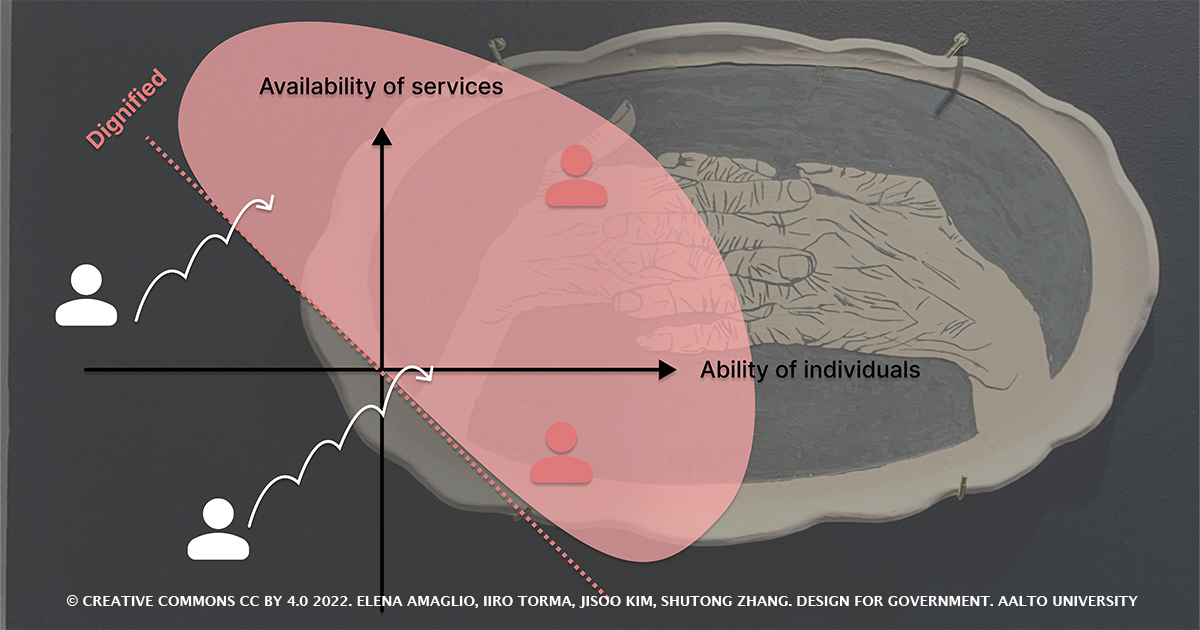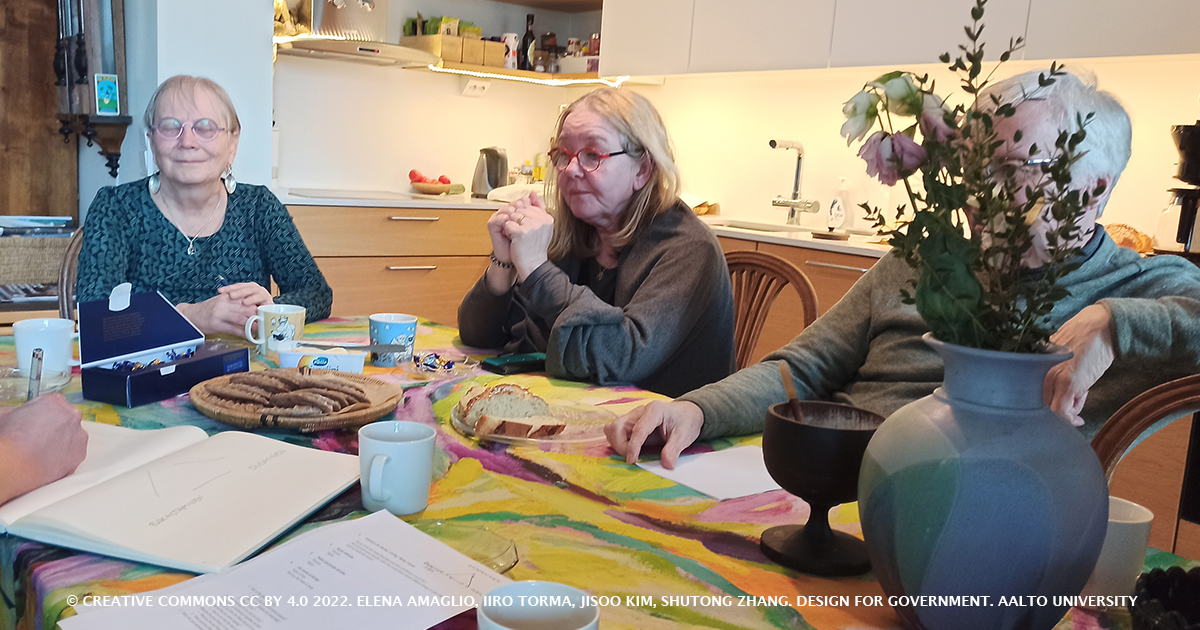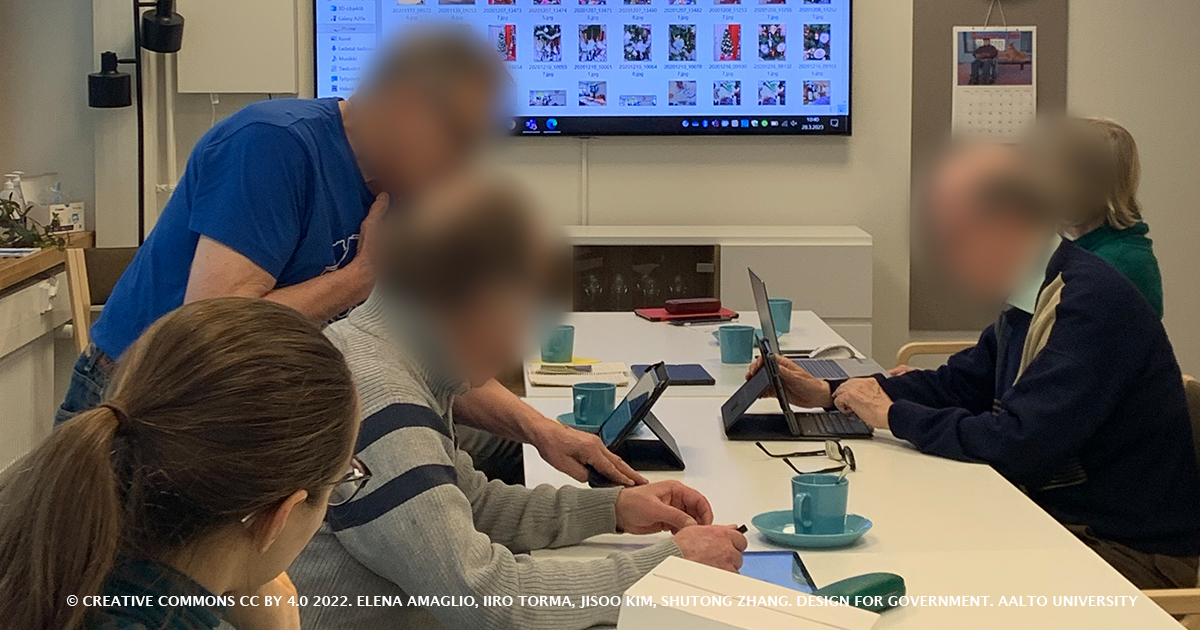This blog post reports on work-in-progress within the DfG course! The post is written by group 1A, working in collaboration with the Digital Population and Data Services (DVV) and the Ministry of Finance (VM) on the project ‘Life events for a dignified old age’. ‘Life events for a dignified old age’. The group includes Elena Amaglio, Jisoo Kim and Iiro Torma from the Collaborative & Industrial Design program and Shutong Zhang from the Creative sustainability program.
Written by: Elena Amaglio
Here we go again! It’s been another three weeks since our last post, and now it’s my turn to tell you how the project for a “dignified old age” is progressing. We have spent the past three weeks investigating the realities of elderly individuals in Finland. As already announced by my colleague Shutong in the last post, we have been reading 25 academic articles published by two leading journals in the gerontological field: “Gerontology” and “ROSEnet”. The findings reflect the reality of older adults in Finland from an academic perspective, combining insights from people themselves and their experiences. The population is becoming increasingly heterogeneous regarding the cultural background and self-care skills. In addition, Ageism marginalises the voice of older people, and finally, technological developments discriminate rather than include. So yes, Finland is the happiest country to live in, but some things still need to be fixed.
Thanks to the desktop research phase and some considerations from the subsequent interviews, we could describe what a dignified old existence meant for us. For us, a dignified life means having the possibility of choice. Choosing where to live, how to travel, whom to see, what to eat, for example. In our research, we identified two key elements to realise a “dignified old life”: the first is when individuals have sufficient abilities (economic capital, social capital, health, etc.). The second is when people no longer have these abilities, and institutions (private or public) provide services to make up for the shortcomings. We have called this the system of Abilities & Availability of Services.

Fig. 2: Ability-Availability system represented as the cross chart. In the background, the decoration is made by a woman in a retirement house.
Another aspect of the dignity of the not-abled seniors is related to the working conditions of healthcare workers, as highlighted by Kaisa Eskelinen in her article “The skills of a good employee in home care regulated by IT operational control” (2023). This link often goes unseen, yet these professionals are critical to living the fourth age with dignity. Likewise, if the goal is to enable individuals who no longer can care for themselves to have a dignified life, in that case, institutions must provide the best possible work possibilities. A straightforward “taking care of those who take care of them”!
A small village in a big city

Fig. 3: Group interview with the three co-founders of the co-house we visited.
Another indispensable part of our research was the collection of first-hand experiences. One of our many observations and interviews stood out the most for me. We had the opportunity to visit a self-managed apartment construction. This building was created by three friends who decided to live together in their third and fourth ages. Their community looks like a small village within a big city, with everyone connected. This housing type takes its cue from the “Ageing together” (Botero & Hyysalo, 2013, p.37-54) of the 2000s that developed in the Arabia area. However, in the community we visited, the residents are of different ages, so they can care for each other when needed. This type of housing shocked me because it seemed like a small island paradise where I, too, would like to live out my old age.
Unfortunately, as studies show (Bell & Napoli, 2023), these co-houses are uncommon examples, and they are rare because they need special skills for their creation and maintenance. Strengthening individual citizens’ understanding of the careful long-term planning required to design these locations is challenging. The ability to plan future solutions in advance is a skill and a privilege that only some have. Most of the characteristics that create heterogeneity in the target population are due to individual choices and the different life courses of each person. Therefore, at least in Finland, one can only start early enough to develop one’s dream retirement.
Digitalisation as a tool? This tool requires a stick!

Fig. 4: Observation of the Digital Club hosted in the retirement home. The Digital Club is guided by volunteers from ENTER ry.
In a retirement home, we observed a digital literacy help group for older people. It is a service provided by ENTER ry, an association of volunteers who work in peer-to-peer sessions to help older adults become more confident using technological tools. What immediately jumped out at them was the questioning sentence: “Why do these technological tools always have to change? Can’t a new computer work like an old car? With just one button!” -Elderly woman,75-80. Trying to use her laptop
Many sources revealed that digital literacy is crucial for using certain services nowadays. The motivations for wanting to learn are diverse, but what moves people is not the need to use an online service but being able to hear your child living on the other side of the world or watch a lecture you are so interested in.
A final observation that struck me is that even people who have acquired important digital skills do not feel the need to update with technological advances once they enter retirement age, if they do not have a strong personal drive. Lack of digital literacy at this age tends to lead to discrimination and the addition of unnecessary barriers when using online services. Here, I ask myself whether, when creating new services, platforms and technologies, more attention would be placed on accessibility for older people. I wonder if what is being done will bring benefits and what kind of exclusion this will create.
To wrap up the blog, a final observation on digitisation through the lens of Donella Meadows reading (2008) we went through in class. Her unique idea was to associate digitisation with what she coins as “Dependency”. Meadows explains that, within a system, factors can become a hindrence as they create dependency. How dependent is our system on digitisation? How dependent do we want the future system to be on it? Is this inevitable? This development is communicated as a great promise to the younger and older generations, are we sure that digitisation is the solution to our ills? And if this is the future we want, we hope through this project, to prompt our partner’s efforts to consider future needs that will come with implementing the great promise.
References:
(n.d.). ENTER ry. Retrieved 2 Apr 2023, from https://www.entersenior.fi/
Andrea Botero & Sampsa Hyysalo (2013). Ageing together: Steps towards evolutionary co-design in everyday practices, CoDesign. International Journal of CoCreation in Design and the Arts, 9:1, 37-54
Bell, A., & Napoli, C. (2023, 02 13). Future consumers 2025. Villages of care. WGSN. https://www-wgsn-com.libproxy.aalto.fi/fashion/article/6387b5d5995aec17a4f6d6e6
Eskelinen, K. (2023). The skills of a good employee in home care regulated by IT operational control. Gerontology, 37 (1), 4–20. https://doi.org/10.23989/gerontologia.110608
Gerontologia. (n.d.). Journal.fi. Retrieved 2 Apr 2023, from https://journal.fi/gerontologia/index
Meadows, D. H. (2008). Thinking in Systems: A Primer. Chelsea Green Publishing.
Walsh, K. (n.d.). ROSEnet COST ACTION (CA 15122). Retrieved 2 Apr 2023, from http://rosenetcost.com/
The DfG course runs for 14 weeks each spring – the 2023 course has now started and runs from 27 Feb to 31 May. It’s an advanced studio course in which students work in multidisciplinary teams to address project briefs commissioned by governmental ministries in Finland. The course proceeds through the spring as a series of teaching modules in which various research and design methods are applied to address the project briefs. Blog posts are written by student groups, in which they share news, experiences and insights from within the course activities and their project development. More information here about the DfG 2023 project briefs.

